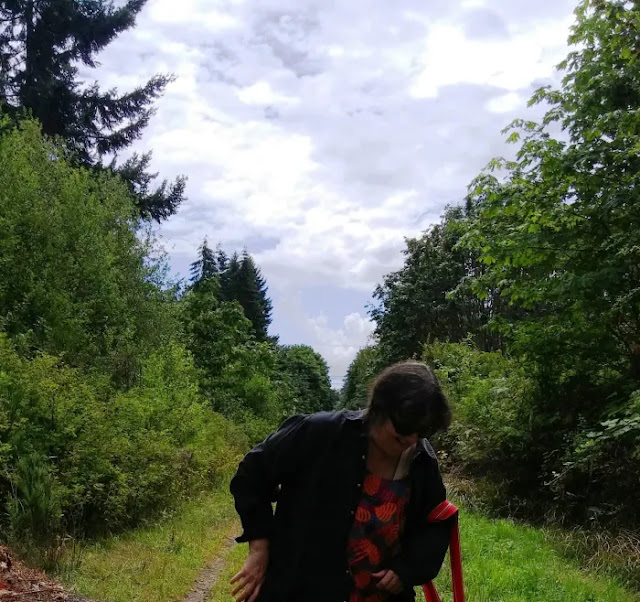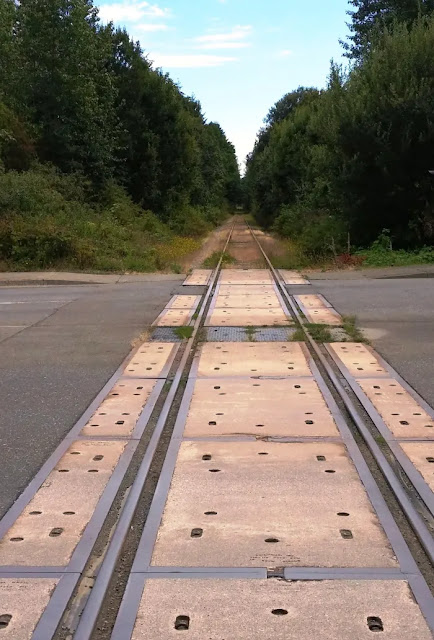 |
| A Piece of the E & N Railroad that used to run through the Comox Valley |
Walking Was Natural
I was a walker as a child and a youth. By myself, or with friends or family, I gamboled happily through the chunks of rural and small-city Saskatchewan where I grew up. Before I even started to school I have a recollection of walking with a little friend along the highway to the village near our farm. When a truckful of labourers pulled over to offer us a ride, I was aghast when Richard readied himself to jump on the truck and had to grab him and yell to them, "No thank you, we only have a few blocks to go." Blocks? On a highway? Well, I'd been a child walker/runaway on the suburban streets of Vancouver for a couple of years while my young parents looked into the future away from the farm. The point was that pedestrian children did not take rides from strangers.
So, while our farm was a wheat and grain operation, and I didn't have "chores" per se, I did engage in a lot of physical activity. I would be dispatched to pick up groceries on my bike (for which I put a chocolate bar on the tab with the other groceries) and I frequently walked down to the little river to swim, or over to a neighbour's place a couple of miles away. Sometimes I had to walk to school if we got up late and missed the schoolbus. And I walked, skipped, and did the pre-60s version of a jog, all over the farm. Often I walked around the school at recess with friends, or around the sportsground with best friends after school. Walked and talked.
I was thin and fit and I had confidence in my ability to do a lot of things, because if I just put one foot in front of the other, well, stuff got done.
I Stopped Walking. I Got Fat. I Got Old
I went away to College. I met a lovely man who walked because he didn't own a car. We walked for miles through the rain in our courtship, through the early part of our marriage and taking turns carrying our first child.
Then we got jobs that required a vehicle. We lived out of the city. We walked less.
When at some point my husband took up hiking and running and the odd half-marathon, our younger son remarked, "Dad, you're the Half-Marathon Man"-- a wordplay on the movie "Marathon Man" starring Dustin Hoffman, but a comment which repeated today doesn't elicit a chuckle because younger folks don't know what I'm talking about.
I walked less.
And less and less and less.
Let's Go For A Walk (Shock)
So, yesterday when I announced that I would like us to walk to town, my husband looked confused and rather shocked.
He is always up for any sort of connubial physical activity. His love language is, of course, physical activity together. I, on the other hand, prefer sitting at my computer in the kitchen facing the garden so that I can swoop outside at intervals to bring in a bucket of berries or whatever might be needed for a meal.
"Yes, I want to walk to town. I have been thinking about doing that since we moved here." Eleven years ago. And I have actually meditated on how nice that would be. If I hadn't lost those two FitBit Pedometers (one to the clothes dryer and one to parts unknown), I am quite certain I would now have been making that trip to town on Shank's Pony on a fairly regular basis.
So, off we headed. The walk down to the highway was pretty do-able. Downhill all the way. I prevented myself from obsessing about the climb up the hill on the way home.
There was a lot of traffic. It is July and we do live in a tourist destination by the ocean above the scenic route into and out of the city, so, yes, traffic is heavy right now
He suggested that we take a slightly unorthodox route into town, along the old out-of-use E&N Railroad. And then we could take the bus home, another 'first' for me in this community.
It was a gorgeous day in one of the World's most exquisitely beautiful settings. I have no difficulty in stating that. The Comox Valley, Vancouver Island, is noted for its glorious four-season location-- snow-capped mountains, ocean, lakes, rivers, green grass in the winter. Small organic fruit and veggie farms. Ancient-growth rain forest and a healthy mix of people who have lived here all their lives, boomers moving in from all over Canada, big box stores and a cheerful little downtown that is reminiscent of the downtowns of all small towns in Canada in my 50s-60s girlhood.
And even the ditches have beautiful flowers growing in them, I remark.
 |
| Beautiful flowers even grow in ditches on Vancouver Island. |
Railroad-ed
We followed Royston Road up to where the E & N Railroad crossed and turned onto the sun-swathed route that was the dilapidated railroad. My husband, political observer, frequent visitor to the Regional District office, and avid writer of letters-to-the-editors of local newspapers, was delighted to fill me in on the history of this railroad and the fact that there is apparently $12 Million earmarked to remove the old ties, lay down new ones and get it running again.
 |
| The peace of walking along an overgrown railroad in the summer sunshine! |
Blackberry Bushes Are Bastards
An Amazing Nature Walk
The rails along this old track had a certain arty charm, so far-gone are they. The less attractive ones are clad in old creosote, a dark brown oil distilled from coal tar and used as a wood preservative. I am interested to see that the ugliest creosote ties have, indeed, survived all the wet and fungus, whereas the ones without creosote have broken down into small tinder wood gardens. I also wonder if new railroad architects have come up with a preservative less harsh on the environment than creosote. Gardeners are warned off using old railroad ties in their veggie gardens because of a Public Health Statement of the Environmental Protection Agency to the effect that the coal in creosote, a dark brown oil distilled from coal tar and used as a wood preservative. I am interested to see that the ugliest creosote ties have, indeed, survived all the wet and fungus whereas the ones without creosote have broken down into small tinder wood gardens. I also wonder if new railroad architects have come up with a preservative less harsh on the environment than creosote. Gardeners are warned off using old railroad ties in their veggie gardens because of a Public Health Statement of the Environmental Protection Agency to the effect that the coal in creosote is probably carcinogenic to humans.Ties to the Past
Nature is Therapeutic
 |
| Bee grapples to extract nectar from clover |
 |
| A delicate bright yellow bloom pops up from a nest of weeds. Can you identify it? |
 |
| What I called Indian Paintbrush as a kid but that is probably something else! |
 |
| A pile of apples--an offering to the deer, perhaps??? |
A Different Perspective
 |
| Switch Tracks Build-A-Log-Cabin Kit business off the overgrown track!! |
 | ||
|
 |
| Taking the dog for a walk |
 |
| Here is a pretty ingenious weather-proof way to get back to the meadow on one side of the tracks and through the bush into Walmart (and buses) on the other side of the track |
 |
| A ferny oasis in Millard Park, along the railroad |
 |
| A new walking/cycling trail that we knew nothing about runs iust between the old railroad and the commercial in between. |
 |
| Here is the crossing at 26th Street where we left the railroad and headed down the hill to the Driftwood Mall. |





Comments